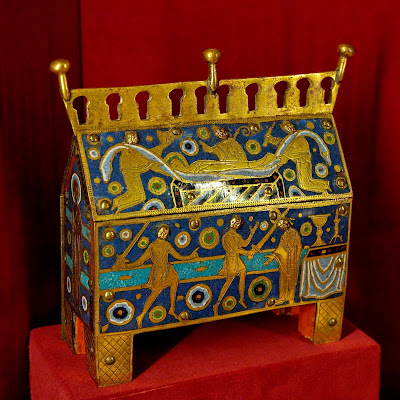Cross-posted from Monstrous Beauty.
This is something I only became aware of a few years ago. During the 15th century in in Burgundy, especially during the time of Philip the Good, there was a trend of making luxury manuscripts on vellum that had been dyed black. Unfortunately, the process of dying the vellum made it brittle and fragile, so these manuscript did not survive in great numbers. There are fewer than twenty surviving manuscripts and only three of them are still bound as codices. The remainder are preserved as single leaves, often pressed in acrylic to protect them. So far as I know, all of the surviving examples are Books of Hours. The Pierpont Morgan Library has one, and this is a two page spread from it. The illumination on the left is of the Descent of the Holy Spirit.
While I'm not a huge fan of Books of Hours, this is certainly striking.
Wednesday, June 22, 2011
Thursday, June 9, 2011
Limoges Enamal Châsse.
Crossposted from Monstrous Beauty
I must confess a certain ignorance when it comes to medieval metalwork and enamels. But here is a pretty thing.
This is Châsse or casket from Limoges, c. 1190-1200. A Châsse was a reliquary shaped sort of like a house with a sloping roof and triangular gabled ends. Limoges was center enamel work at the time. This is Champlevé enamel. Champlevé is created by casting a metal piece with impressions for the area to be enameled. The depressions are then filled with powdered glass. The entire piece is the fired and the glass melts and fuses with the metal.
This is reliquary for St. Thomas Becket. The main body shows his murder while the roof shows his entombment. On the end is a saint, probably Becket himself.
The reliquary is in the Musée de Cluny in Paris.
Image wikipedia.
I must confess a certain ignorance when it comes to medieval metalwork and enamels. But here is a pretty thing.
This is Châsse or casket from Limoges, c. 1190-1200. A Châsse was a reliquary shaped sort of like a house with a sloping roof and triangular gabled ends. Limoges was center enamel work at the time. This is Champlevé enamel. Champlevé is created by casting a metal piece with impressions for the area to be enameled. The depressions are then filled with powdered glass. The entire piece is the fired and the glass melts and fuses with the metal.
This is reliquary for St. Thomas Becket. The main body shows his murder while the roof shows his entombment. On the end is a saint, probably Becket himself.
The reliquary is in the Musée de Cluny in Paris.
Image wikipedia.
Subscribe to:
Comments (Atom)


